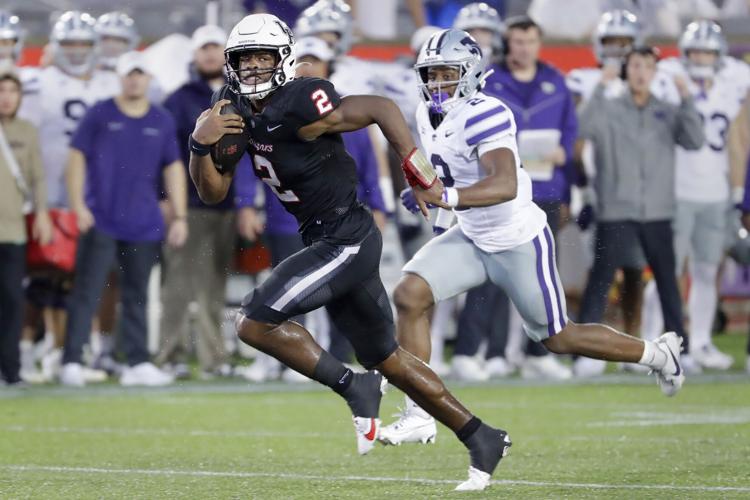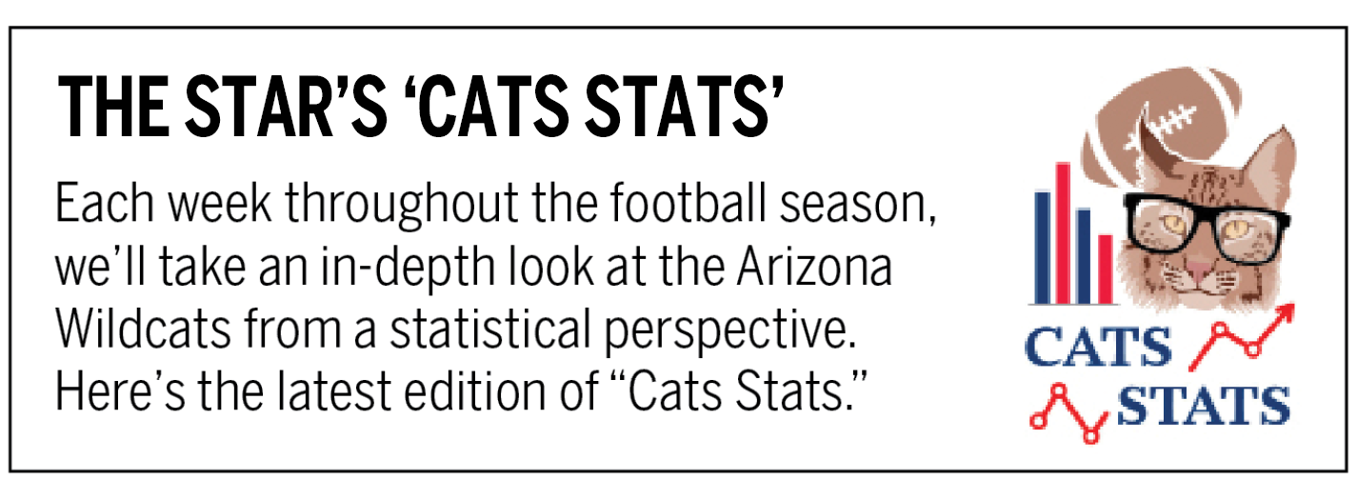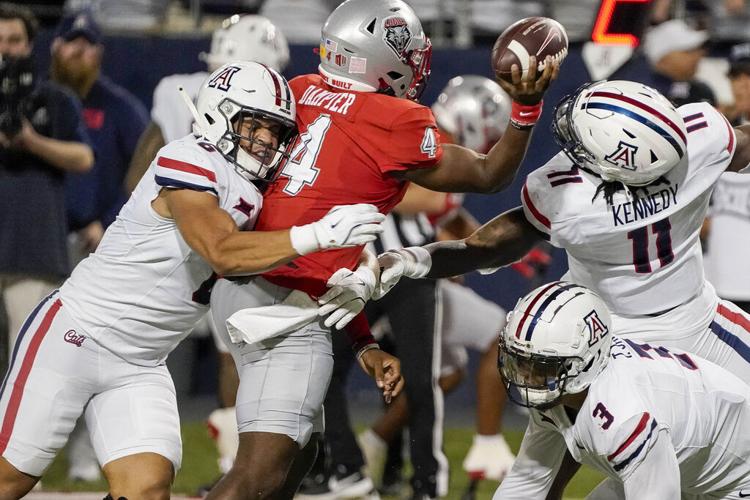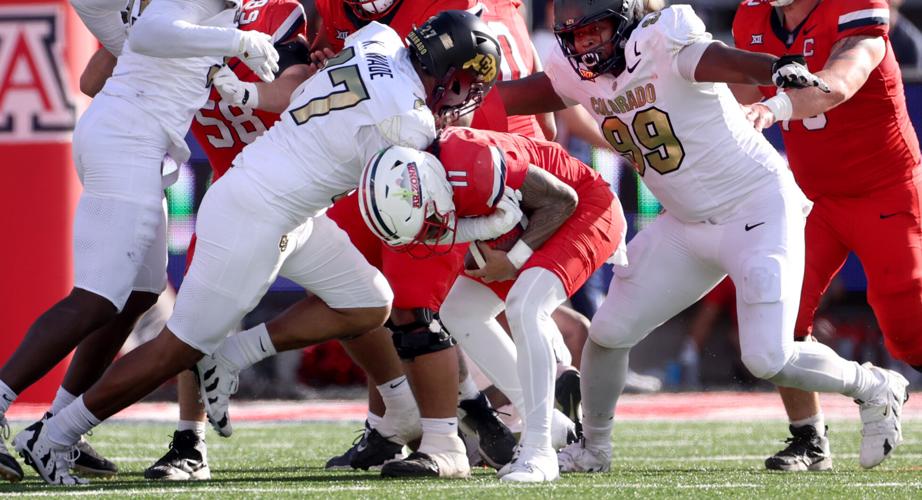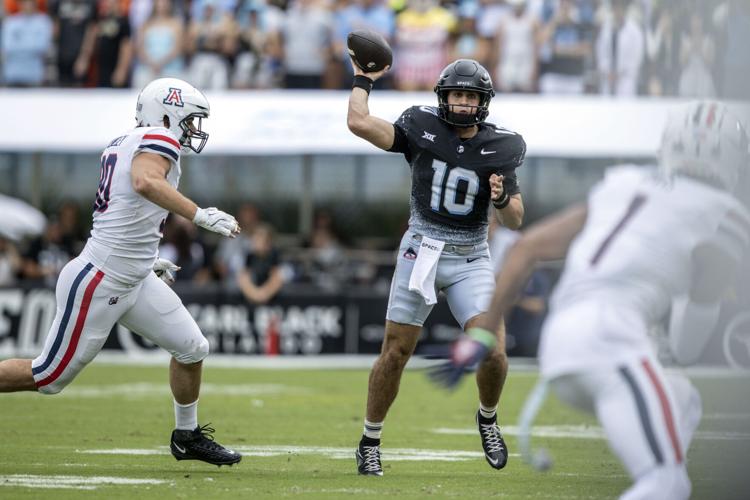These are desperate times for Arizona football.
Losers of five in a row — including a rock-bottom blowout at UCF — the Wildcats have to win out to secure a bowl bid.
They might be fighting for their head coach’s job less than a year into his regime.

They are viewed by the oddsmakers as no better than an even match at home against Houston, which, despite a recent surge, still ranks last in the Big 12 in multiple offensive categories.
Arizona really needs a win Friday night — to keep hope alive, to quiet the haters (if that’s even possible) and to boost morale in the locker room.
In this week’s “Cats Stats,” we’ll explore five areas where the Wildcats need to improve to end their five-game losing streak. They don’t have to nail all five to beat the Cougars. But it wouldn’t hurt.
People are also reading…
QB containment
Houston’s turnaround — the Cougars have won three of their past four after starting 1-4 — didn’t happen by accident. When Willie Fritz named Zeon Chriss the starting quarterback, Houston started playing better.

Houston quarterback Zeon Chriss runs for a touchdown as Kansas State safety Colby McCalister pursues during the second half of their game Nov. 2, 2024, in Houston. Containing the speedy Chriss will be critical for Arizona on Friday night.
Chriss, a transfer from Louisiana, is an accurate, low-volume passer. He is an elite runner.
Chriss ripped off a 71-yard run against TCU on Oct. 4. He rushed for 97 yards that night. He had 75 in Houston’s upset of Kansas State on Nov. 2.
Remember when corralling mobile quarterbacks was Arizona’s biggest problem? It hasn’t been a headline of late because the Wildcats have so many other issues. But it’s something that easily could resurface Friday.
New Mexico’s Devon Dampier and KSU’s Avery Johnson each surpassed 100 yards rushing against Arizona, combining for 240 in Weeks 1 and 3. The Wildcats can’t let Chriss approach 100.
They can’t let him scurry for first downs the way UCF’s Dylan Rizk did. Rizk — who isn’t in Chriss’ class as an athlete — rushed nine times for 55 yards against Arizona. Four of those runs gained first downs. One was a 33-yard scramble on third-and-10.

Arizona defensive players Taye Brown, left, Chase Kennedy (11) and Tre Smith (3) put pressure on New Mexico quarterback Devon Dampier during the first half of the Wildcats’ season-opening matchup on Aug. 31 in Tucson.
The Wildcats need to swarm Chriss. The redshirt sophomore averages 3.92 yards per carry after contact and has forced 25 missed tackles, according to Pro Football Focus. Arizona had a season-high 23 missed tackles vs. UCF, per PFF. That can’t happen again.
Even with Chriss providing a spark, Houston still ranks last in the Big 12 in scoring, total offense, passing offense, third-down efficiency and red-zone touchdown percentage. Contain Chriss and you’ll likely curtail the Cougars.
Pressure, Part 1
When Chriss does drop back to pass, the Wildcats need to make him uncomfortable. They haven’t done that to an opposing quarterback in weeks.
In Arizona’s first five games, the defense averaged 20.8 QB pressures, per PFF. In the past four, that number has plummeted to 7.3.
Getting to Chriss without blitzing would appear to be the best path to success. He has thrived against the blitz, completing 69.2% of his passes with a 3-0 touchdown-to-interception ratio, per PFF. When not blitzed, Chriss is just as accurate (69.0%) but more turnover-prone (1-3 TD-INT).
UA defensive coordinator Duane Akina suggested more four-man fronts could be utilized this week after he trended away from that in the previous three games. We suggest crowding the line of scrimmage against Chriss and daring him to throw over the top. He has completed only 1 of 5 passing attempts with 20-plus air yards this season with zero touchdowns and one interception.
Chriss was better as a deep passer last year at Louisiana — 11 of 25, 3-2 TD-INT — but it’s a risk worth taking. Make him prove he can do it.
The Wildcats can’t be reckless with their rush; that’s what got them in trouble earlier in the season. But they can be relentless. The more bodies Chriss has to dodge, the better.
Pressure, Part 2
On the other side of the ball, Arizona has to give Noah Fifita a chance. He’s barely had time to breathe lately, let alone throw.
Opponents have compiled at least 18 individual defensive pressures in each of Arizona’s last seven games, per PFF. Fifita has been the second-most-pressured quarterback in the nation this season with a total of 134 team pressures on his dropbacks.

Colorado defensive end Keaten Wade (27) and defensive lineman Shane Cokes (99) swarm over Arizona quarterback Noah Fifita and register a sack in the fourth quarter of their Big 12 matchup on Oct. 19 in Tucson.
Although he’s been more effective against pressure in recent games, Fifita is like most other quarterbacks in this area: He’s better with a clean pocket.
Fifita has completed 68.5% of his passes with a 9-5 TD-INT ratio when kept clean, per PFF. When under pressure, those numbers are 45.0% and 4-5.
Arizona’s injuries and issues along the offensive line have been well-chronicled. That unit has struggled, especially against blitzes and edge pressure. Another lineup tweak could be coming this week. Utilizing some of the schematic changes we saw vs. West Virginia — such as deploying tight ends and running backs on the wings to chip-block edge rushers — wouldn’t be a bad idea either.
Houston has one of the better defenses in the Big 12 — the Cougars rank second in total defense (318.9 ypg) and fifth in scoring defense (22.0 ppg).

Colorado safety Savion Riley, left, takes Arizona running back Kedrick Reescano off his feet in the fourth quarter of their Big 12 game on Oct. 19, 2024, at Arizona Stadium.
They have not sacked opposing quarterbacks very often. Houston and Iowa State are tied for last in the league with 12 sacks apiece.
Run the ball
Arizona rushed for 161 yards in its last win, at Utah on Sept. 28. These are the Wildcats’ rushing totals since then: 121, 114, 107, 78, 5.
That is not a favorable trend.
Arizona won’t beat anyone rushing for 5 net yards; 105 isn’t really enough, either. You’d like to see that number in the 150 range.
Is that possible against Houston? The Cougars’ game log suggests that it is.
The Cougars have held five opponents to less than 100 yards on the ground. But the other four foes rushed for at least 149 yards, including two (Iowa State, Kansas) that topped 200. Those four averaged 201 yards.
Arizona would need to remain committed to the run to get anywhere near there. If the game plays out as expected — close and low-scoring — that would help.

UCF quarterback Dylan Rizk (10) passes the ball against Arizona during the first half of their game Nov. 2, 2024, in Orlando, Fla.
The Wildcats currently rank 13th in the Big 12 at 115 rushing yards per game — and last with 250 rushing attempts (231 if you exclude sacks). San Jose State was rarely a run-heavy team under Brent Brennan, but the 2023 Spartans ranked fifth in the Mountain West in rushing (184.1 ypg) and first in yards per carry (5.6). It can be done.
Third-down defense
The UA defense has struggled to get off the field the past three games.
Arizona allowed Colorado, West Virginia and UCF to convert 22 of 43 third downs — 51.2%. (The Mountaineers and Knights also converted 5 of 5 fourth downs.) In the first six games, the Wildcats held opponents to a respectable 38.7% conversion rate.
They were healthier then, and it’s been challenging since to win those one-on-one battles that are critical in third-down situations. Houston presents an opportunity to turn that around.
The Cougars aren’t just last in the Big 12 in third-down conversion rate at 27.7% — they’re 130th out of 133 FBS teams.
Houston has proved it can win without converting many third downs; the Cougars went a combined 6 for 27 (22.2%) against Utah and KSU and prevailed anyway.
But that’s not a sustainable formula. Nor is Arizona’s recently leaky third-down defense. Chriss can’t hurt the Wildcats if he’s standing on the sideline.
Contact sports reporter/columnist Michael Lev at mlev@tucson.com. On X(Twitter): @michaeljlev














